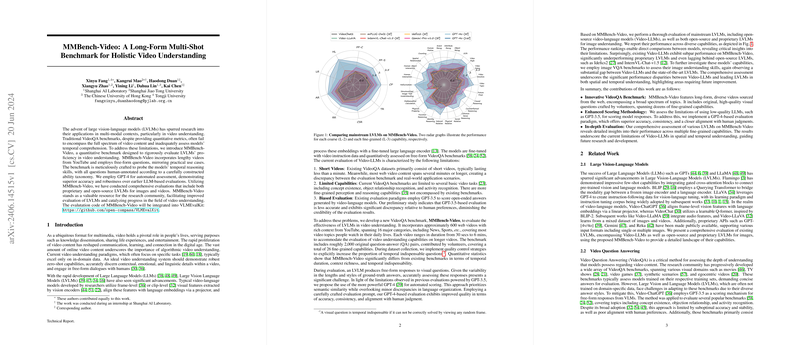Analyzing MMBench-Video: A Benchmark for Comprehensive Video Understanding
The paper "MMBench-Video: A Long-Form Multi-Shot Benchmark for Holistic Video Understanding" presents a new benchmark explicitly designed to evaluate the video understanding capabilities of Large Vision-LLMs (LVLMs). The authors address significant limitations in existing Video Question Answering (VideoQA) benchmarks and propose MMBench-Video as a more rigorous and holistic benchmark. This essay will explore the methodological innovations, evaluation results, and implications of MMBench-Video for future research in video understanding.
Key Innovations in MMBench-Video
MMBench-Video is marked by several crucial innovations that differentiate it from previous benchmarks:
- Comprehensive Video Dataset:
- Source and Diversity: The benchmark is built from lengthy videos sourced from YouTube, covering 16 different categories such as News, Sports, and Knowledge, thereby mirroring real-world video consumption patterns.
- Temporal Coverage: Videos included in MMBench-Video range from 30 seconds to 6 minutes, significantly longer than those in most existing benchmarks. This inclusion of long-form content is vital for assessing temporal reasoning capabilities.
- Enhanced Question-Answer (QA) Pairs:
- Fine-grained Taxonomy: The benchmark employs a hierarchical capability taxonomy with 26 fine-grained abilities, spanning both perception and reasoning domains. This offers a nuanced evaluation of LVLMs.
- Temporal Indispensability: Special emphasis is placed on formulating temporally indispensable questions that cannot be answered from a single frame, thus rigorously testing the models' temporal comprehension.
- Robust Evaluation Framework:
- Automated Evaluation with GPT-4: The authors utilize GPT-4 for scoring model responses, with a 3-grade marking scheme designed to prioritize semantic similarity and align with human judgments, addressing shortcomings in prior evaluation methods that utilized GPT-3.5.
Evaluation Insights
The paper presents exhaustive evaluations of both proprietary and open-source LVLMs using MMBench-Video, shedding light on the following insights:
- Performance Disparities:
- Video-LLMs vs. Image LVLMs: Surprisingly, existing open-source Video-LLMs lag behind image-based LVLMs such as Idefics2-8B and InternVL-Chat-v1.5 in temporal reasoning and overall video understanding, revealing a significant performance gap.
- Proprietary LVLMs: Models like GPT-4o and Gemini-Pro demonstrate superior performance, notably surpassing open-source counterparts. For instance, GPT-4o achieves an overall score significantly higher than the best open-source Video-LLM.
- Temporal and Spatial Understanding:
- Frame Input Influence: The number of input frames significantly impacts the performance of LVLMs. Proprietary models, when processing multiple frames, show marked improvement in both perception and reasoning tasks.
- Hallucination Reduction: Hallucination remains a significant challenge for many models, indicating the need for improved training mechanisms to address misinformation generation.
- Role of Auxiliary Data:
- Incorporating Subtitles: The integration of YouTube-generated subtitles notably enhances model performance, particularly in reasoning tasks, by leveraging rich contextual information from speech.
Implications and Future Directions
The introduction of MMBench-Video profoundly impacts both practical and theoretical aspects of video understanding research. Practically, this benchmark provides a valuable resource for the comprehensive evaluation of LVLMs, guiding the development of more capable and robust models. Theoretically, the detailed insights into the fine-grained capabilities and limitations of existing models offer a foundation for future advancements.
Future Developments:
- Enhanced Temporal Model Architectures: There is a clear need for developing models that can better integrate temporal information, perhaps through more sophisticated temporal fusion techniques or memory-augmented architectures.
- Broader Dataset Inclusion: Expanding MMBench-Video to include even longer videos or more varied content types (e.g., documentaries, tutorials) could further its comprehensiveness.
- Fine-tuning with Rich Contexts: Incorporating more contextual data, such as surrounding text or audio, could enhance the models' understanding of nuanced video content.
In conclusion, MMBench-Video represents a significant advancement in the benchmarking of video understanding capabilities in LVLMs. By addressing existing limitations and setting new standards for evaluation, it paves the way for the next generation of video comprehension models. Future research should build on the insights gleaned from MMBench-Video, focusing on creating more temporally aware and contextually enriched vision-LLMs.
